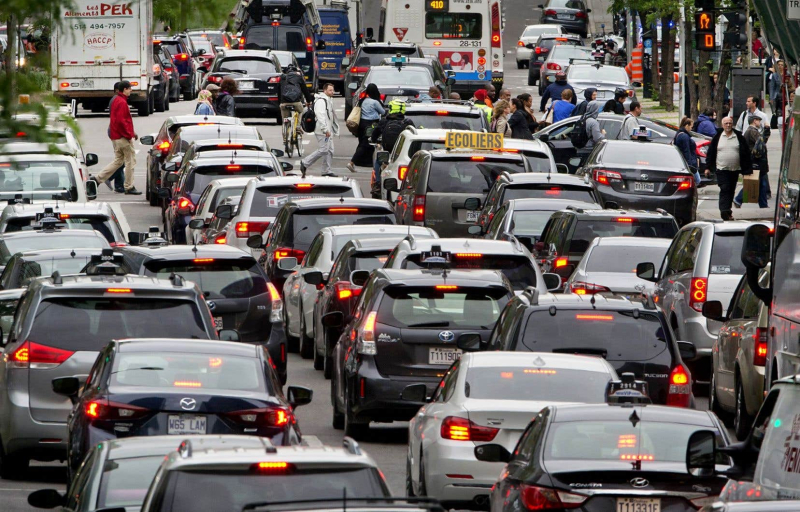
Photo: Jacques Nadeau Archives Le Devoir Quebec has reduced its GHGs by 9% since the reference year of 1990, while the objective for 2030 is a reduction of 37.5%.
Stéphane Blais – The Canadian Press
Posted at 3:44 p.m. Updated at 7:30 p.m.
- Quebec
The government of Quebec would have identified and financed 67% of the measures to achieve the objective of 37.5% reduction in greenhouse gases by 2030, according to the Implementation Plan (PMO) 2024-2029, which includes for the first time a component on energy efficiency and sobriety.
During a technical briefing on Tuesday, officials from the government presented the fourth update of the Green Economy Plan 2030 (PEV 2030), with a record financial framework of more than $10 billion for five years.
Plan update includes:
– $4.0 billion to reduce GHG emissions in the transport sector;
– More than $2 billion to maintain and develop the transport supply collective and its electrification and to support active transportation;
– $1.5 billion to support the acceleration of the electrification of light vehicles;
– $1.7 billion to support the decarbonization of industries and $1.5 billion to make buildings more sustainable;
– $1 billion to reduce GHG emissions using renewable energies other than electricity.
“The implementation plan that we are presenting to you today is essentially two fronts, both very important, that is to say the fight against greenhouse gas emissions and adaptation to climatic changes. And in the end, if we consider the budgets themselves, we are talking about a 40% increase compared to the first version which was presented in 2020,” explained the Minister of the Environment, Benoit Charette, during a press conference.
Measures identified at 67%
The Implementation Plan “provides for fully defined and funded measures starting this year, which will allow us to achieve 67% of our GHG emissions reduction target , marking an increase of seven percentage points compared to the previous edition”, indicated the minister.
However, there is still a long way to go before reach the target.
Quebec has reduced its GHGs by 9% since the reference year of 1990, while the objective for 2030 is a reduction of 37 .5%.
In 1990, Quebec emitted 85.1 megatons of CO2 equivalent (Mt CO2 eq.), while GHG emissions will be 79.1 megatons for the year 2022, according to the document presented on Tuesday, or 3.1 megatons less than the pre-pandemic level of 2019.
This is, however, 1.8% more than the 77.6 million released into the atmosphere in 2021.
Energy sobriety
200% Deposit Bonus up to €3,000 180% First Deposit Bonus up to $20,000The PMO includes for the first time a component on energy efficiency and sobriety, which has a budget of nearly $900 million for the five next few years.
As a journalist pointed out to the Minister of the Environment during the press conference, the update of the plan, which is presented in a 66-page document, contains the term “sobriety” 19 times.
According to the government's definition, energy sobriety must make it possible to reduce energy demand by “a reduction in needs at source” and it “consists of reviewing our consumption habits in order to prioritize essential needs by moving away from those which would be superfluous.”
The Implementation Plan gives as an example the replacement of “the use of the car by the bicycle” or the reduction “by one degree the heating temperature in winter.”
At a press conference, Minister Charette explained that sobriety “is not necessarily sacrifices that are imposed” and “that there are behavioral changes that will be necessary”, sometimes “voluntarily, but often accompanied by financial incentives”.
The PMO highlights that existing government programs and measures alone represent more than $786 million of these investments, and cites the ÉcoPerformance, Éconologis and Rénoclimat programs as examples.
In order to “double annual electricity savings by 2030”, the government intends to inform owners of residential buildings of the energy performance of their residence.
Also, Hydro-Québec will install high energy performance technologies, such as heat pumps, in low-rent housing.
More than $15 million will be invested to improve the energy productivity of large industries and the government will “set an example and reduce, starting next year, heating and air conditioning in its buildings with the collaboration of the Société québécoise des infrastructures” .
New measures in agriculture
The update of the 2030 Green Economy Plan includes a new specific measure for the agricultural sector of $20 million.
This funding should make it possible to assess “the risks for each sector (field crops, dairy production, aquaculture, etc.) and to provide agricultural producers with the tools and support necessary for their adaptation to climate change “.
The funding of $20 million is in addition to the amount of $62 million that was planned for the next five years to support the agricultural, bio-food sectors and peaches.
The PMO emphasizes that in agriculture, “the reduction potential of 1.6 Mt in 2030 would arise mainly from the destruction or valorization of methane from manure as well as the adoption of agricultural practices making it possible to reduce the use of 'nitrogen fertilizer and emissions from enteric fermentation'.
Nature Québec invites us to use “more of nature”
Nature Québec welcomed “the improvements presented in the 2024-2029 Implementation Plan” as the investments announced in order to better understand the role of ecosystems in mitigation climate change.
The organization also congratulated the government for having integrated several recommendations from the Group of Experts on Adaptation to Climate Change in the update of the EPI.
However, Nature Québec believes that the government “will not be able to achieve its climate targets without protecting, restoring and improving the management of ecosystems.”
L' organization suggested in particular that Quebec finance adaptation to floods through the State's Environmental and Water Protection Fund, “using available funds to restore wetlands and water environments in order to cope with episodes of extreme weather which is increasing.”

